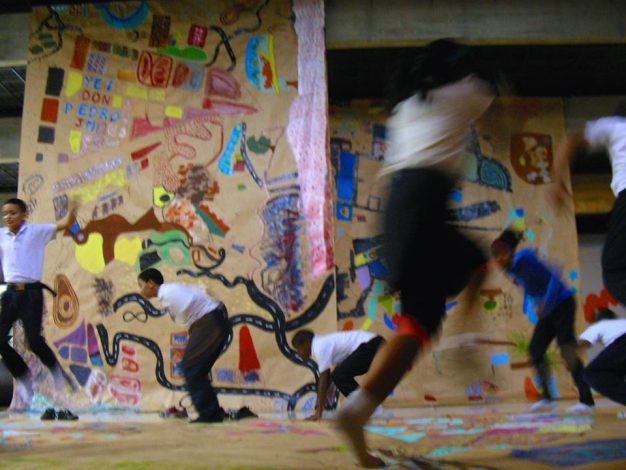
MAPEA: an integrating social art project in Venezuela
Natalya Critchley was a poster presenter at the last Child in the City International Seminar in Antwerp. In this article, she expounds on the MAPEA Project she presented.
Venezuela is in crisis and we have serious difficulties maintaining a social art project while children still there are in dire necessity of these activities. Venezuela is currently in free-fall with an imploding economy [1]. The capital, Caracas, is protected from the worst of the power outages and lack of food, but beyond the capital, the population is bearing the brunt of the shortages. School is a luxury many children soon will not remember [2]. Despite this slow-motion train wreck, we have tried to keep our social art project MAPEA [3] running over the last four years, even as members of the team gradually disperse abroad and conditions in the country become ever more restricted. Some of us continue vital work there. We recognise that at a certain point the crisis opened opportunities for experimentation we may not have been afforded previously, but it can only go on for so long before you cannot supplement every deficiency with private resources.
Project MAPEA: to walk, to feel, to reflect upon, to map out, to act upon… Awakening sensibilities and stimulating empowerment in children and adolescents.
As in so many cities in the developing world, much of the urban growth was unplanned, notably in peri-urban ‘slum’ shantytowns or barrios often physically and socially juxtaposed to planned middle and upper class urbanisations. MAPEA [3] was convened as a group comprising artists, activists, actors and architects in 2015 to address this long noted distinction between two urban realities: the hyper designed, rigid urban space and the organic, dynamic, flexible and contested areas of squatter settlements. The latter have grown in Caracas to occupy a quarter of the territory while housing more than half the population. And these are the spaces that need recognition as part of the city instead of existing in eternal limbo.
The present art project came about to identify this difference in visual terms, and to initiate a conversation about the city we want to have through multidisciplinary workshops that combine walkabouts, corporal expression exercises and the painting of large collective maps in cultural spaces adjacent to the barrios we work with. My conceptual references were mapping activities used by urban planners and Augustó Boal’s roleplaying method in theatre [4].
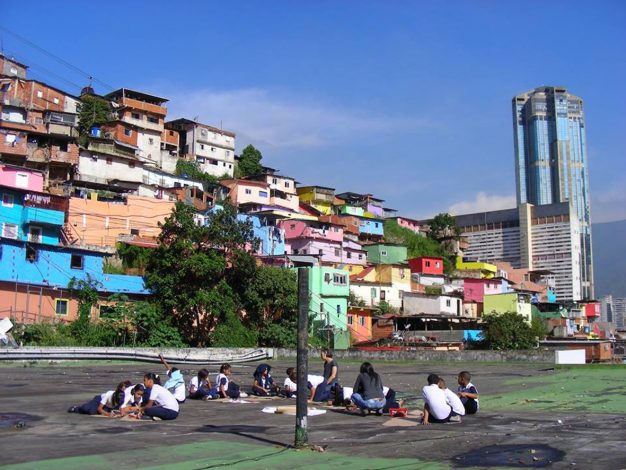
Establishing bridges between the barrio and cultural centres where, inexplicably, no connection exists.
Our first experience was the San Agustín del Sur Tourism Office (OT- SAS) in the Museo de Arte Contemporáneo (MAC) in October 2015, which is located right next to the populous and long-established barrio of that name (Fig 1). Following a drawing commission of the cable car being built there (Fig 2), I worked with a community group that identified local tourism as a possible industry that would be sustained by the new transport system [5].
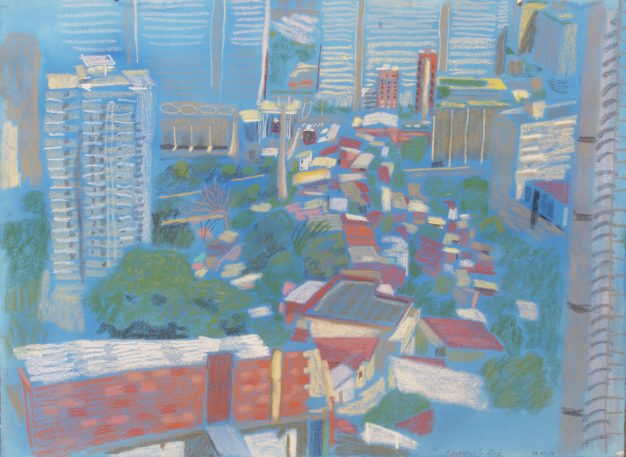
‘Museums should be places where you raise questions, not just show stuff’.
In support and promotion of this idea by William Thorsell, OTSAS was conceived to showcase and make available to the public the many projects for urban regeneration in San Agustín. The mapping workshops were performed in the main exhibition hall and the installation grew as 400 students from three local schools participated in over two months of workshops (Fig 3). The map format (500 x 700 cm) was designed to create an immersive painting experience, large enough for a group of 30-50 children to work on simultaneously. In the shapes and lines that appeared, we could appreciate the sinuous contours of the barrio as it adapts to the original geography of the valley, contrasting with the flattened grids of the city. Conversations on ecological concerns stimulated the greening of the painting.
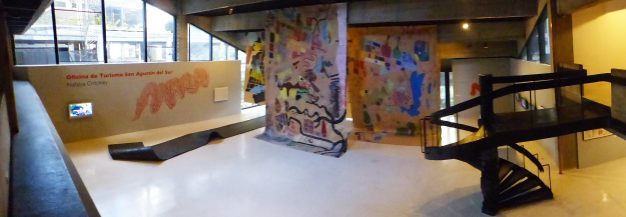
We insisted on disrupting the sacrosanct atmosphere of the museum as a temple, breaking with the inertia that conceives it as a passive experience (Fig 4). We wanted to generate a more active use of the space for a large population that does not consume culture in a conventional way. This took five years to achieve, as we were often redirected to use the education department of the museums, rather than turning the workshops themselves into part of the spectacle and experience.
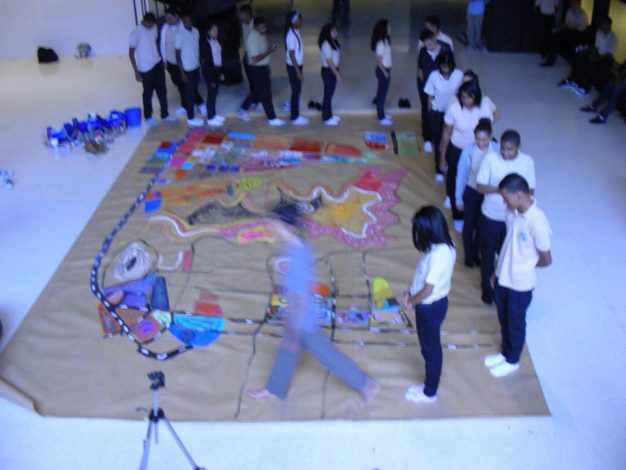
We want to experience street level realities with children and adolescents while enjoying public spaces in an open, free and creative way.
So far we have managed to carry out three additional editions of the project: Centro Cultural “Padre Carlos Guillermo Plaza”, Universidad Católica Andres Bello (UCAB), Caracas, March 2017; Museo de Arte Contemporáneo del Zulia (MACZUL) with the indigenous Wayúu community, Maracaibo, February 2018; and Barrio El Calvario and Centro de Arte El Hatillo, El Hatillo, 2018. We have two new exhibitions planned, currently on hold until conditions in the country improve. Amid such turmoil, it is unclear how much we could really achieve, although children desperately need to be creatively engaged as a respite from the violence, immersed as they are in such an adverse learning environment. We always insist during urban walkabouts on the possibility of turning abandoned weed filled areas into gardens (many native plants are medicinal) and encourage the creation of vegetable gardens in schools [6].
In OTSAS, the walkabout visits to the Bolivar I Organic vegetable garden next to the museum were a highlight (Fig 5). On weekends Afro-Venezuelan cooking workshops were held for the public in the museum cafe with ingredients grown there and combined with walking tours of the barrio organised by local students. This is the role of art and cultural centres we envision that truly advocates integration.
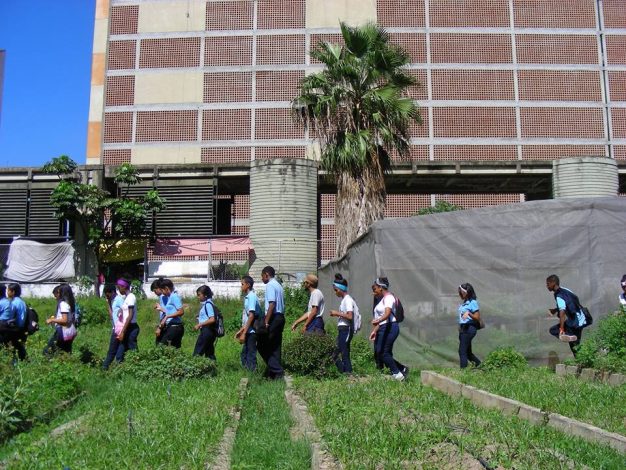
Acknowledgements
I am grateful to MAC, UCAB, MACZUL, Fundación Wayúu Taya and Alcaldía El Hatillo for institutional support and to Banco Occidental de Descuento for funding. I am also deeply indebted to my committed workshop assistants: Laura Bastidas, Héctor González, Mónica Santander, Edgar Carrasco, Carlos Fabián Medina, Liseth González, Yoandy Medina, Pedro Laya, Andrés Catalano and Franklin Sánchez, and to all the people and communities who have contributed to MAPEA projects. A special mention to Claudio Mendoza, Cheo Carvajal and Humberto Valdivieso without whose support this would not have been possible.
References
- Kurmanaev, A. (2019, May 17). Venezuela’s collapse is the worst outside of war in decades, economists say. New York Times. https://nyti.ms/2HQm8tY
- Cabrices, R. O. (2019, May 7). How to read Venezuela’s chaotic power struggle. Caracas Chronicles. https://bit.ly/2Ie9IuW
- Critchley, N. Walking, mapping opening doors. Natalyacritchley.com. https://bit.ly/ 2HU43eE
- Theatre of the Oppressed, Wikipedia. https://bit.ly/1K8sMsj
- O’Shaugnessy H. (2011, July 1). Caracas cable and sky’s the limit. Natalyacritchley.com.https://bit.ly/2HQja8C
- García Alcaraz, T. Urban agriculture in Caracas. [Polis]. https://bit.ly/312CabE


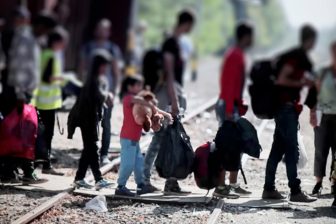


Extraordinary and wonderful experience!!
Venezuelan children urgently need to have the opportunity to express their creativity and to think through art about the urban space.
Thank you natalya!
And thank you to Child in the City to share this experience!